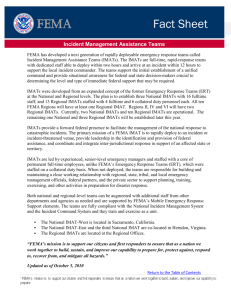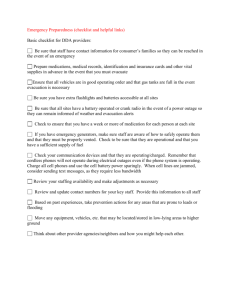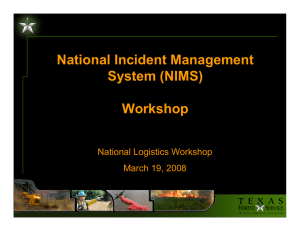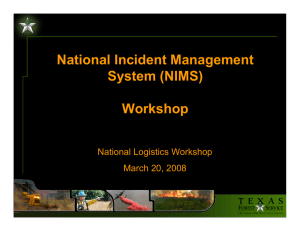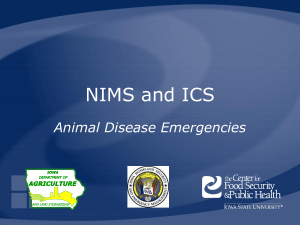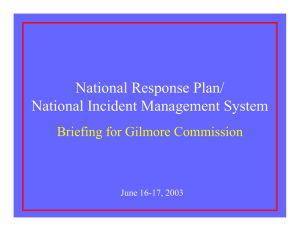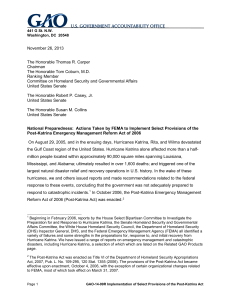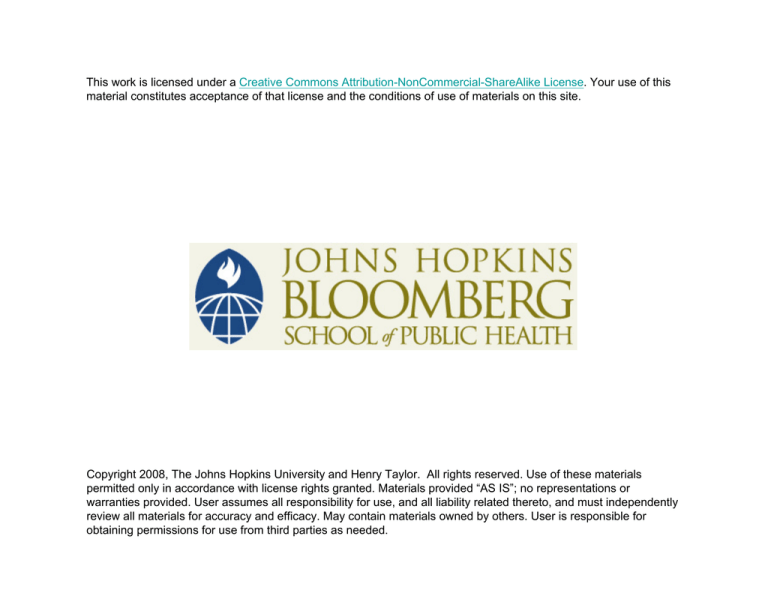
This work is licensed under a Creative Commons Attribution-NonCommercial-ShareAlike License. Your use of this
material constitutes acceptance of that license and the conditions of use of materials on this site.
Copyright 2008, The Johns Hopkins University and Henry Taylor. All rights reserved. Use of these materials
permitted only in accordance with license rights granted. Materials provided “AS IS”; no representations or
warranties provided. User assumes all responsibility for use, and all liability related thereto, and must independently
review all materials for accuracy and efficacy. May contain materials owned by others. User is responsible for
obtaining permissions for use from third parties as needed.
Public Health Preparedness
Core Concepts
Bio-terrorism’s Impact
• The FBI investigates acts of terrorism
• Federal funding goes through the State
• Criminal issues are handled by state police, county
sheriffs, and municipalities
• County Boards of Health and the State Public Health
Commissioner have certain “police powers” to restrict
civil liberties
Notes Available
Newest Essential Service
• Definition of Terrorism: The unlawful use of force or
violence against persons or property to intimidate or
coerce a government, the civilian population, or any
segment thereof, in furtherance of political or social
objectives
• How is this different from Winslow’s social machinery?
Notes Available
State & Local Responders
Coordinate Many Different Groups
•
•
•
•
•
•
•
•
•
Health care providers and facilities
Local and state health departments
Emergency management agencies
Search and Rescue, EMS, and HAZMAT
Volunteers
Law enforcement, National Guard
State emergency management agency
Political leaders
Community service organizations
Photo by Will Tung. Creative Commons BY.
National Responders SUPPORT
State & Locals
•
•
•
•
•
•
•
Health and Human Services (HHS)
Centers for Disease Control and
Prevention (CDC)
Federal Emergency Management
Agency (FEMA)
Environmental Protection Agency (EPA)
Department of Agriculture
Department of Defense
FBI
Photo by Xuan Qin. Creative Commons BY-NC-SA.
Emergency Operations Command
• County emergency operations command (EOC)
– Activated by the county government
– Includes police, fire, administrative, IP, health, Red
Cross, operations, and communications support for
emergency situations
– Local health department is active member
(or should be…)
– DHS National Response Framework accepts as a
“basic premise” that “incidents are generally handled
at the lowest jurisdictional level possible.”
Emergency Response Seems Chaotic
• An emergency occurs and is detected by:
Local
Localcitizen
citizen
Calls 911
Health
Healthsurveillance
surveillancesystem
system
Local
Localhealth
healthjurisdiction
jurisdiction
Local
Localemergency
emergencymanagement
managementoffice
office
Local
Locallaw
lawenforcement
enforcement
FBI
FBI
Notes Available
Fire
Fire
Clinician/hospital
Clinician/hospital
State
Statehealth
healthdept
dept
State
StateEmergency
EmergencyMgt
MgtDept
Dept
HAZMAT
HAZMAT
EMS
EMS
National Response Doctrine Key
Principles
•
•
•
•
•
Engaged Partnership
Tiered Response
Scalable, flexible, and adaptable operational capabilities
Unity of effort through Unified Command
Readiness to Act
From http://www.fema.gov/emergency/nrf
Public Health Response
Infrastructure
Prepared
PreparedWorkforce
Workforce
They
Theyhave
havecompetencies
competencies
Systems
Systems&&Relationships
Relationships
Surveillance,
Surveillance,partner
partner
contacts,
contacts,&&laboratory
laboratorydata
data
Data
Data&&Information
Information
AApracticed
practicedplan
plan
and
andconnections
connections
to
toother
otheragencies
agencies
Adapted from Academy Health, June 8, 2004.
The Preparedness Cycle
Plan
Plan
Evaluate
Evaluate&&Improve
Improve
Capability
Capability
Building
Building
Organize,
Organize,Train,
Train,&&Equip
Equip
Exercise
Exercise
Adapted from http://www.fema.gov/emergency/nrf/ downloaded 5/6/08 from National Response Framework PDF.
The Response Process
Gain
Gain&&Maintain
Maintain
Situational
SituationalAwareness
Awareness
Activate
Activate&&Deploy
Deploy
Resources
Resources&&Capabilities
Capabilities
Coordinate
CoordinateResponse
Response
Actions
Actions
Demobilize
Adapted from http://www.fema.gov/emergency/nrf/ downloaded 5/6/08 from National Response Framework PDF.
Surge Capacity Definition
•
•
•
•
A health care system’s ability
To rapidly expand
Beyond normal services
To meet the increased demand for:
– Qualified personnel
– Medical care, and
– Public Health
• In large-scale public health disasters
Notes Available
15 Emergency Services Functions
1. Transportation
2. Communications
3. Public Works,
Engineering
(Damage Assessment)
4. Fire Services
5. Emergency
Management
6. Mass Care (Red Cross)
Emergency Assistance
7. Logistics Management
Resource Support
Defined by PL93-288 as amended, “the Stafford Act”
8. Public Health and
Medical Services
9. Search & Rescue
10. Hazardous Materials,
Envt and CBRNE Agents
11. Agriculture & Nat Res
12. Energy and Utilities
13. Public Safety & Security
14. Long-Term Community
Recovery
15. External Affairs
NIMS and NRP
NIMS
• Aligns command, control,
organization structure,
terminology, communication
protocols, and resources
Resources
• Used for all events
Expertise
Federal
Federal
Response/Support
Local
Response/Support
Response
State
State
Response
Response/Support
or Support
Federal
Local
Response
or Support
Response
Incident
Abilities
NRP
• Integrates and applies Federal
resources, knowledge, and
abilities before, during, and after
an incident
• Activated only for Incidents of
National Significance
Incident Command System
•
•
•
•
•
•
ICS originated in fire services in the
1970s as FIRESCOPE
ICS establishes a command and
response organizational structure that
all responder groups accept and
understand
On-scene, all-hazard concept that has
been proven to succeed when applied
properly
Based on organizational best
practices
Interdisciplinary and organizationally
flexible
Appropriate for all types of incidents
Photo by Jenny Ryan. Creative Commons BY.
Functional Responsibilities: IFLOP
What Do I Do Under Incident
Command?
1.
2.
3.
Determine the Incident
Commander
–
Usually Health Officer or
Designee
Determine who you report to
–
You may be working under
a different supervisor and
alongside or under
individuals from other
agencies.
Receive your job assignment
–
No matter what your job, all
staff serve as eyes and ears
for the Health Department,
by communicating anything
out of the ordinary.
4. Get/bring supplies or
specialized equipment
5. Use ‘clear text’ radio and phone
communications
– No acronyms, or ‘codes’
6. Organize and brief
subordinates
7. Brief relief personnel
8. Complete required forms
9. Participate in debriefing
Source: Dan Barnett, Johns Hopkins Center for Public Health Preparedness
Metropolitan Medical Response System
US Department of Homeland Security. Public Domain.

